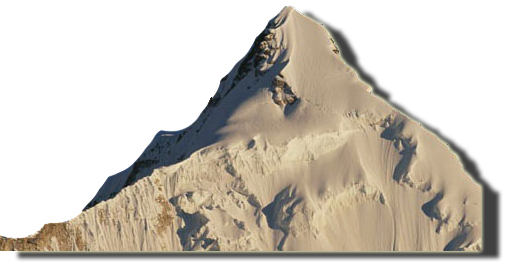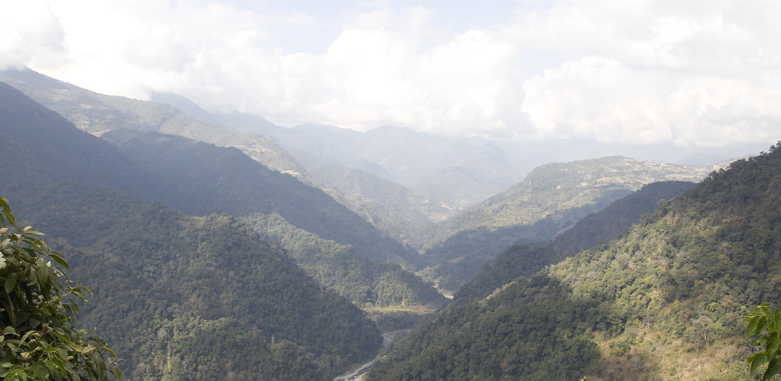
Jhomolhari Trek II
- 12 Nights 13 Days
- Western Bhutan
Duration: Tweve
Nights Thirteen Days (Trek- 8 days)
High Season: March, April, May,
September, October & November
Low Season: January, February, June, July,
August & December
| Jan | Feb | Mar | Apr | May | Jun | July | Aug | Sept | Oct | Nov | Dec |
Max. Elevation: 4,890
metres above sea level
Highest Camp: 4,080 metres above sea level
Standard: Medium
Best Seasons: April to June, September to November
Start: Drugyal Dzong (Paro)
Finish: Drugyal Dzong (Paro)
Jhomolhari Trek II Summary:
Itinerary Outline:
Day 1: Arrive Paro
Day 2: Day hike to Tiger’s Nest Monastery
Day 3: Drugyal Dzong - Sharna Zampa (Trek Begins)
Day 4: Sharna Zampa- Thangthangkha
Day 5: Thangthangkha - Jangothang
Day 6: Jangothang Halt.
Day 7: Jangothang to Dhumzo
Day 8: Dhumzo to Thombu Shong
Day 9: Thombu Shong to Sharna Zampa
Day 10: Sharna Zampa to Drugyal Dzong (Trek Ends)
Day 11: Paro to Thimphu (Thimphu sightseeing)
Day 12: Thimphu to Paro (Thimphu sightseeing)
Day 13: Departure from Paro
Detailed Itinerary:
Day 1: Arrive Paro
Upon being received at the airport by our representative, check into your Hotel. Later, we visit Tag Dzong, built in the 17th Century as a watch tower for Paro Rinpung Dzong. This Dzong was later converted into the National Museum in 1967 and is filled with antique thangkhas (Buddhist paintings on cloth), textiles, antique weapons and armour. Also visit the Rinpung Dzong, also built in the 17th century to defend the valley against Tibetan invaders. It is now used as an administrative centre and home for the Monastic Community. Stroll around town. Overnight at Hotel.
Day 2: Day Hike to Tiger’s Nest Monastery
In the morning, you will visit the Drugyal Dzong (Bhutan Victory Fort) which was built in 1646 to commemorate Bhutan's victory over the Tibetans in the 1600s. On a clear day you can get captivating views of Mount Jhomolhari, Bhutan's second-highest mountain at 7,314 metres. Then you will hike to Taktsang (the Tiger's Nest) Monastery, which is Bhutan's most famous Monastery. It is perched precariously on the edge of a steep cliff 900 metres above the Paro Valley floor. Visit the Monastery and hike back to Paro. In the evening visit a traditional farm house which offers opportunity to mingle with local people and their lifestyle. If you wish, you can have a traditional Bhutanese dinner acompaned by buttermilk or 'Dao' in Dzongkha.. Overnight at the Hotel in Paro.
Day 3: Drugyal Dzong - Sharna
Zampa (Trek Begins)
(Distance 17 km, four to five hours, 360 m ascent, 80 m descent,
camp altitude 2,850 m)
Drive up to Drugyal Dzong (2,580 m) where the road ends and the trek begins. With a gradual climb the trail follows the Paro Chhu passing beautiful meadows, paddy fields and impressive farm houses. After about four hours you will reach the Bhutan Army's post at Gunitsawa village. At the army checkpost, your trek permit (provided by us) will be checked and endorsed. The campsite is on the opposite side of the river not far from Gunitsawa.
Day 4: Sharna Zampa- Thangthangkha
(Distance 22km, seven to eight hours, 770 m ascent, 10 m descent,
camp altitude 3,610 m)
On this long day, the trail continues with lots of small ups and downs. After going uphill through the river valley, you enter the Jigme Dorji National Park. The valley finally narrows gradually to a mere path which descends to a meadow where a camp will be set up. From here, if weather permits, you will have the first great view of Mount Jhomolhari.
 Day
5: Thangthangkha - Jangothang
Day
5: Thangthangkha - Jangothang
(Distance 19 km, five to six hours, 480 m ascent, camp altitude
4,080 m)
If you did not see Mount Jhomolhari (right) last evening, you will have a great chance to get a magnificent view this early morning. This morning the trek continues up the Paro Chhu valley which widens into patches of alpine meadow and scanty growths of forest. Cross an army outpost along the way and enjoy a spectacular view of high mountain ridges and snow-capped peaks. Yaks and the herders' homes become a regular feature of the landscape. Passing the villages of Soe, Takethang and Dangochang is another asset on this day. Reaching Jangothang, one of the most beautiful campsites of the Himalayas, you will again have a spectacular view of Mount Jhomolhari.
Day 6: Jangothang Halt
The day in Jangothang provides plenty of possibilities for day hikes with great views on lakes and snow capped mountains such as Jhomolhari and Jichu Drakey. There are good chances to spot some blue sheep on the upper slopes of the valley. Jangothang is a perfect environment for your acclimatisation. Trek up to Tosoh or hike around the area. There are good short hiking trails in three directions. Jhomolhari and its subsidiary mountain chains lie directly west, Jichu Drakey to the north and a number of unclimbed peaks to the east.
Day 7: Jangothang to Dhumzo
(Distance 16 km, six to seven hours, 810 m ascent, 1,090 m descent,
camp altitude 3,800 m)
The trail leads to the last settlement
in the valley and drops to the Paro Chhu. Passing the lake of Tshophu
(4,380 m) you will climb up steeply to Bhonte La pass at 4,890 m, the
highest point of this trek route. Reaching the Dhumzo Chhu river, you
trek downstream passing the few houses of Dhumzo to arrive at your camp
soon after.
Day 8: Dhumzo to Thombu Shong
(Distance 11 km, four to five hours, 720 m ascent, 340 m descent,
camp altitude 4,180 m)
The trail climbs 100m over a ridge to
drop to another stream then. After crossing the Takhung La pass (4,520m)
you descend to Thombu Shong, where there are three yak herders’
huts with your campsite next to them.
Day 9: Thombu Shong to Sharna Zampa
(Distance 13 km, four to five hours, 200 m ascent, 1,650 m descent,
camp altitude 2,850 m)
Crossing Thombu La pass (4,380 m) you will finally reach Gunitsawa and
the campsite of your first night of this trek.

Trekking across the valleys of Bhutan...
Day 10: Sharna Zampa to Drugyal Dzong
(Distance 17 km, four to six hours, 80 m ascent, 360 m descent)
Once you reach a primary school and a shop, the valley opens. From Mitshi Zampa you can see how the Dzong is positioned and how the path takes you finally to Drugyal Dzong.
Day 11: Paro to Thimphu
Morning we head out through the relaxing countryside of terraced rice fields interspersed with rhododendron and pine forests as we make an hour’s drive to Thimphu, the tiny capital at 7,600 feet (2316 metres). En route, we see our first examples of Bhutan’s remarkable traditional architecture, one of the country’s unique cultural treasures. Even the most remote village farmhouses are hand-crafted using the same ancient methods used to create Bhutan’s religious fortresses called "Dzongs". Afternoon, we visit the Tashichhodzong. The ‘Fortress of the Glorious Religion’ houses the Throne Room of His Majesty the (Fifth) King, Jigme Khesar Namgyel Wangchuck, the Main Secretariat Building and the Central Monk Body. Its courtyard is open to visitors during the off-office hours (on weekends and weekdays after 4 pm (winter) and 5pm (summer). Overnight at your Three Star Hotel.
Day 12: Thimphu to Paro
At the heart of Thimphu visit the Third King's Memorial Chorten (Stupa) built in 1974 where you will find many devotees circumambulating the Chorten. You will also visit the Changangkha Lhakhang ('Lhakhang' means temple), the Jungshi Paper factory where they make traditional Bhutanese paper, the National Library that houses the world’s largest book, ancient Buddhist texts and manuscripts, a Painting School famous for traditional thangkha ('thangkha' is a religious painting), visit the Folk Heritage Museum founded by Her Majesty the Queen Mother, Ashi Dorji Wangmo Wangchuck. The museum is one of a kind that portrays the lifestyle of a genteel family in the Thimphu valley in the olden days. Visit the Choki Handicrafts shop where Bhutanese textiles and other handicrafts are displayed and can be purchased. The shop is closely linked to the Choki Traditional Art School- many of the goods are produced in the school itself and all proceeds go towards the upkeep of the school and the provision of tuition for the students. Evening return to Paro. Overnight at Hotel.
Day 13: Departure from Paro
It is goodbye for now from us here at Bhutan Rebirth and hope we can Hello again.
Note: These trekking itineraries have been designed based on past experiences of visitors to Bhutan and what they experienced about various trek routes. They show the actual duration of the trek only. They can be combined with other cultural tours or treks. The treks are such that you can gain the maximum out of this experience without exhausting you. The treks may depend on seasons. However, these readymade itineraries may not be convenient for some visitors. That is why we would be very happy to, together with you, design a new itinerary to fit all criteria and interests as desired by you. Please write to us with your special interests and/or requirements at bhutanrebirth@gmail.com.
| |
BACK TO TREKS MAIN PAGE |
